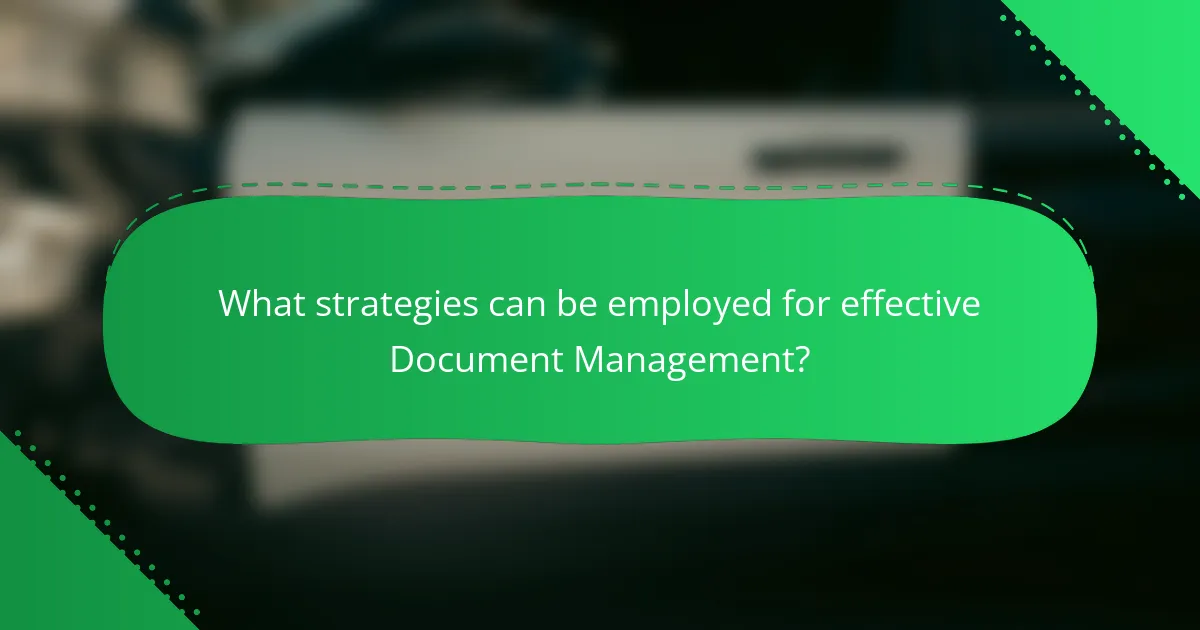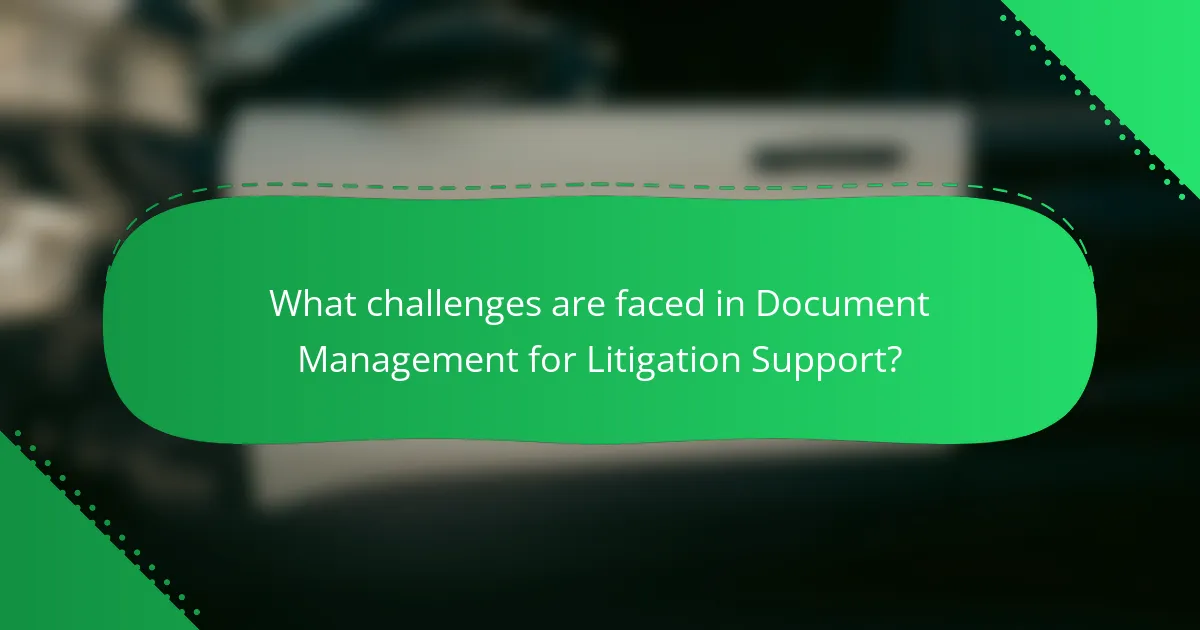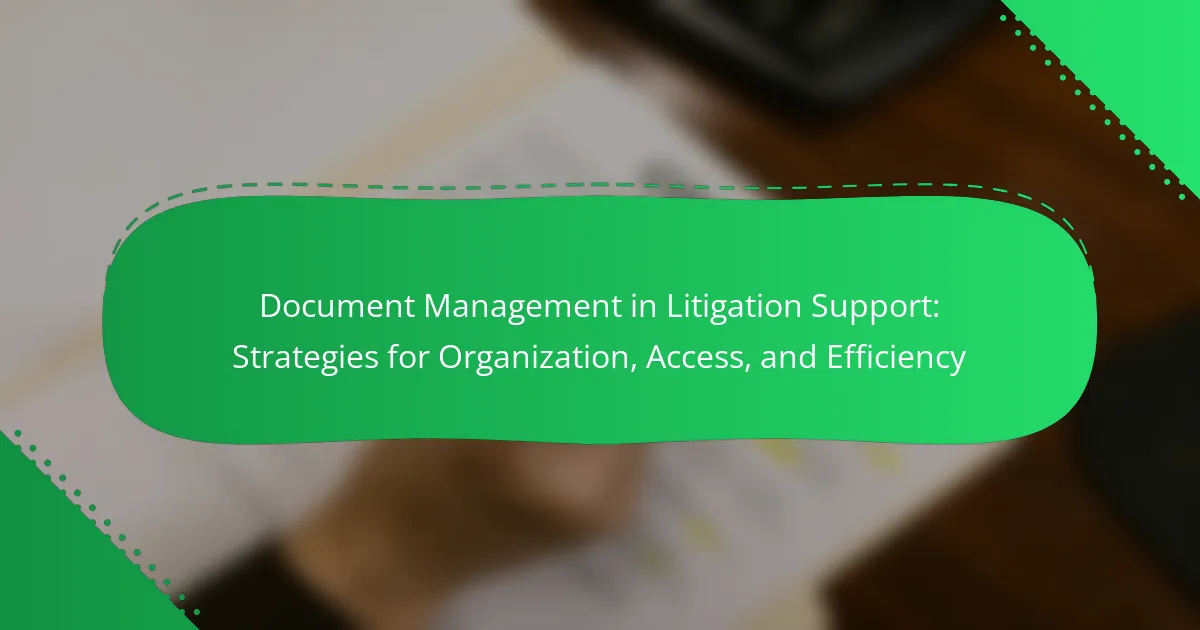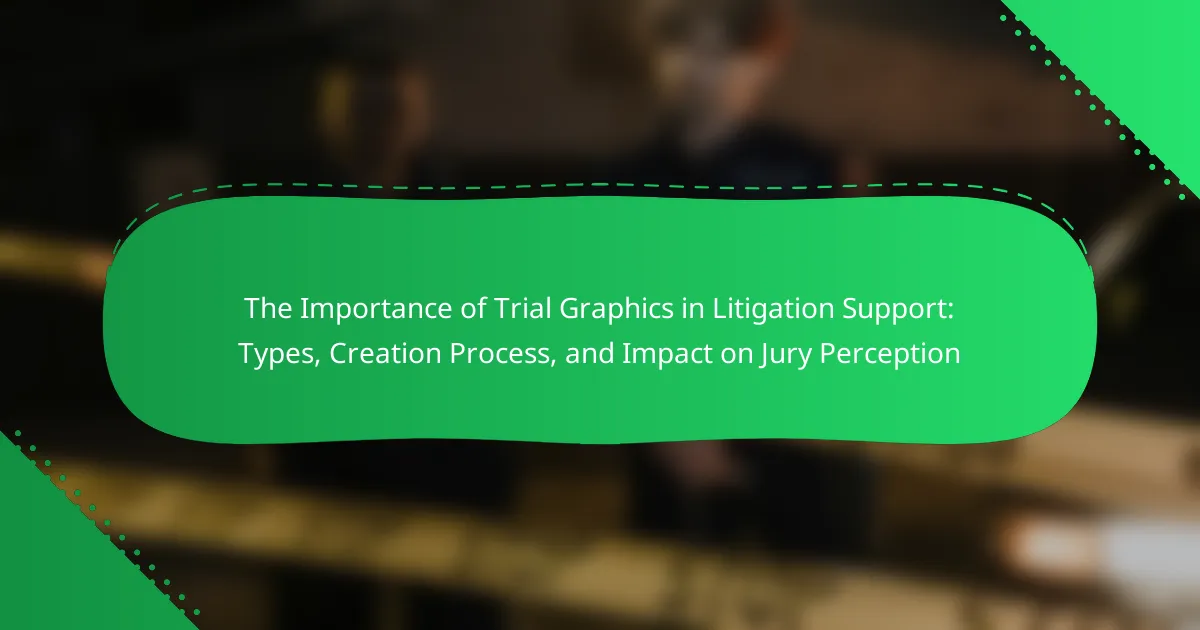Document management in litigation support is the structured organization, storage, and retrieval of documents pertinent to legal cases. This article outlines the importance of effective document management for enhancing efficiency and accuracy in legal proceedings. Key strategies include implementing a centralized system, categorizing documents for better organization, and ensuring proper access controls to protect sensitive information. The article also addresses challenges such as the high volume of documents, compliance with legal standards, and the integration of technology in document management systems. By utilizing these strategies, legal teams can improve collaboration and streamline processes, ultimately leading to more effective case preparation.

What is Document Management in Litigation Support?
Document management in litigation support refers to the systematic organization, storage, and retrieval of documents relevant to legal cases. This process is essential for maintaining efficiency and accuracy during litigation. Effective document management ensures that legal teams can access critical information quickly. It involves categorizing documents based on case requirements and maintaining a secure digital or physical archive. The use of document management software enhances collaboration among legal professionals. Additionally, it helps in compliance with legal standards and regulations. According to a study by the American Bar Association, efficient document management can significantly reduce time spent on case preparation. This underscores the importance of implementing robust document management practices in legal settings.
How does Document Management play a role in Litigation Support?
Document management plays a crucial role in litigation support by ensuring organized access to relevant documents. It facilitates the efficient retrieval of case materials, which is essential for legal teams. Effective document management systems categorize, store, and track documents systematically. This organization helps in maintaining compliance with legal standards and deadlines. Moreover, it enhances collaboration among legal professionals by allowing simultaneous access to documents. According to a study by the American Bar Association, effective document management can reduce the time spent on document retrieval by up to 30%. This efficiency can significantly impact case preparation and strategy. Overall, document management is integral to the success of litigation support efforts.
What are the key components of Document Management in this context?
The key components of Document Management in litigation support include organization, access, and efficiency. Organization involves categorizing and indexing documents for easy retrieval. Access refers to the ability of authorized personnel to retrieve documents quickly. Efficiency is achieved through streamlined workflows and automated processes. These components ensure that legal teams can manage large volumes of documents effectively. Proper organization reduces time spent searching for information. Enhanced access enables collaboration among team members. Efficient document management ultimately supports successful litigation outcomes.
How do these components contribute to the litigation process?
Components such as organization, access, and efficiency play a crucial role in the litigation process. Effective organization of documents ensures that all relevant information is easily retrievable. This reduces the time attorneys spend searching for evidence. Quick access to documents allows for timely responses to legal inquiries and motions. Efficiency in document management streamlines workflows, minimizing delays in case preparation. Furthermore, organized documentation enhances collaboration among legal teams. This collaborative approach fosters better communication and strategy development. Ultimately, these components contribute to a more effective litigation process, leading to improved outcomes for clients.
What are the primary goals of Document Management in Litigation Support?
The primary goals of Document Management in Litigation Support are to enhance organization, improve access, and ensure efficiency. Effective organization allows legal teams to categorize and retrieve documents quickly. Improved access facilitates collaboration among team members and stakeholders. Ensuring efficiency reduces time spent on document-related tasks. This streamlined process supports timely case preparation and decision-making. Document Management systems also help maintain compliance with legal standards and regulations. By achieving these goals, litigation support teams can manage large volumes of documents effectively.
How does effective Document Management enhance case organization?
Effective document management enhances case organization by ensuring systematic storage and retrieval of information. It allows legal professionals to categorize documents based on relevance and case type. This organization reduces time spent searching for files. Efficient document management systems also enable version control, ensuring that the most current documents are accessible. Additionally, it promotes collaboration among team members by providing shared access to documents. According to a study by the American Bar Association, organized document management can improve case efficiency by up to 30%. This demonstrates the tangible benefits of effective document management in litigation support.
Why is accessibility crucial in Document Management for litigation?
Accessibility is crucial in Document Management for litigation because it ensures that all relevant documents are easily retrievable by legal teams. Efficient access to documents supports timely decision-making during legal proceedings. When documents are organized and accessible, it reduces the risk of missing critical information. According to a study by the American Bar Association, 70% of legal professionals cite document accessibility as vital for case management success. Furthermore, accessible document management systems enhance collaboration among team members. This collaboration is essential for building strong cases and effective communication. In addition, ensuring accessibility can help comply with legal standards and regulations, reducing the risk of penalties. Overall, accessibility directly impacts the efficiency and effectiveness of legal processes.

What strategies can be employed for effective Document Management?
Effective document management strategies include implementing a centralized system, categorizing documents, and ensuring proper access controls. A centralized system allows for easy retrieval and reduces redundancy. Categorizing documents improves organization and facilitates efficient searching. Proper access controls protect sensitive information and ensure compliance with legal standards. Regular audits of document management practices can identify areas for improvement. Training staff on document management protocols enhances overall efficiency. Utilizing technology, such as document management software, streamlines processes and increases productivity. These strategies collectively contribute to a more organized and efficient document management system in litigation support.
How can technology improve Document Management in litigation?
Technology can improve document management in litigation by enhancing organization, accessibility, and efficiency. Advanced document management systems allow for automated indexing and categorization of legal documents. This automation reduces human error and saves time during document retrieval. Cloud storage solutions provide secure access to documents from any location. This ensures that legal teams can collaborate effectively, regardless of physical distance. Additionally, technology enables version control, preventing confusion over document edits. Analytics tools can track document usage and identify bottlenecks in the workflow. These improvements lead to faster case preparation and better resource management. Overall, integrating technology streamlines document management processes in litigation.
What types of software are available for Document Management?
There are several types of software available for Document Management. These include document storage systems, which focus on securely storing files. Workflow management software streamlines document-related processes and approvals. Electronic signature software facilitates the signing of documents digitally. Collaboration tools enable multiple users to work on documents simultaneously. Version control systems track changes and maintain document history. Additionally, cloud-based document management solutions offer remote access and scalability. Each type enhances organization, access, and efficiency in document management.
How do cloud-based solutions benefit Document Management?
Cloud-based solutions enhance Document Management by providing secure storage and easy access. They allow users to store documents remotely, reducing physical space requirements. This accessibility enables team collaboration from various locations. Real-time updates ensure that all users work with the latest document versions. Additionally, cloud solutions offer automatic backups, minimizing the risk of data loss. They also support advanced search features, improving document retrieval efficiency. According to a 2021 report by Gartner, organizations utilizing cloud-based Document Management systems saw a 30% increase in productivity.
What best practices should be followed in Document Management?
Effective document management involves several best practices. First, establish a clear filing system. This system should categorize documents logically for easy retrieval. Second, implement version control. This ensures that users access the latest document revisions. Third, utilize secure access controls. These controls protect sensitive information from unauthorized access. Fourth, regularly back up documents. Regular backups prevent data loss due to unforeseen circumstances. Fifth, conduct audits of document management practices. Audits help identify areas for improvement and compliance with regulations. Lastly, train staff on document management protocols. Proper training enhances efficiency and reduces errors. Following these best practices improves organization, access, and efficiency in document management.
How can a consistent naming convention enhance organization?
A consistent naming convention enhances organization by providing clear and uniform identifiers for documents. This uniformity reduces confusion and facilitates easier retrieval of files. When documents are named systematically, users can quickly understand the content and context. For instance, including dates and relevant keywords in file names aids in chronological sorting and searching. Studies show that 70% of users benefit from organized file structures, leading to increased efficiency. Consistency in naming also minimizes errors in document handling and ensures that all team members are on the same page. Overall, a structured naming approach streamlines document management processes in litigation support.
What role do metadata and tagging play in efficient Document Management?
Metadata and tagging are essential for efficient document management. They enhance organization by allowing documents to be easily categorized and retrieved. Metadata provides key information about a document, such as author, date created, and file type. Tagging adds descriptive keywords that aid in searchability. Together, they streamline access to relevant documents during litigation. Studies show that effective metadata usage can reduce document retrieval time by up to 50%. This efficiency is crucial in legal contexts where timely access to information can impact case outcomes.

What challenges are faced in Document Management for Litigation Support?
Document management for litigation support faces several challenges. One major challenge is the volume of documents. Legal cases can generate thousands of documents, making organization difficult. Another challenge is ensuring compliance with legal standards. Documents must meet specific regulatory requirements for admissibility. Security is also a significant concern. Sensitive information must be protected from unauthorized access. Furthermore, collaboration among legal teams can be hindered by inconsistent document formats. This inconsistency complicates sharing and reviewing documents efficiently. Additionally, maintaining version control is crucial. Multiple revisions can lead to confusion over which document is the most current. Finally, the integration of technology can be a challenge. Many firms struggle to adopt new document management systems effectively, impacting efficiency.
What are common obstacles in maintaining organized documents?
Common obstacles in maintaining organized documents include lack of a systematic filing system. Without a clear structure, documents can become misplaced or lost. Inconsistent naming conventions further complicate retrieval. Time constraints often lead to rushed document management practices. Limited resources can hinder the implementation of effective organization tools. Additionally, frequent changes in personnel can disrupt established processes. Poor digital tools may also contribute to disorganization. These factors collectively impede efficient document management in litigation support.
How can data security concerns impact Document Management?
Data security concerns can significantly impact Document Management by necessitating stricter protocols and technologies. Organizations must implement advanced encryption methods to protect sensitive documents. This can increase costs and complexity in managing document systems. Additionally, data breaches can lead to legal ramifications and loss of client trust. According to a 2021 study by IBM, the average cost of a data breach is $4.24 million. This financial burden emphasizes the importance of prioritizing data security in Document Management strategies. Furthermore, compliance with regulations like GDPR requires organizations to adopt robust data management practices. Failure to comply can result in hefty fines and reputational damage. Overall, data security concerns drive organizations to enhance their Document Management systems for better protection and compliance.
What strategies can mitigate risks associated with Document Management?
Implementing robust access controls is essential to mitigate risks associated with Document Management. This ensures only authorized personnel can access sensitive documents. Regular audits of user access can identify and rectify potential security gaps. Utilizing encryption protects documents during storage and transmission. Establishing a clear document retention policy prevents unnecessary accumulation of outdated files. Training staff on best practices enhances awareness of potential risks. Employing version control minimizes errors from document alterations. Lastly, integrating automated backup solutions safeguards against data loss. These strategies collectively strengthen the security and efficiency of document management systems.
What are the future trends in Document Management for litigation?
Future trends in document management for litigation include increased automation and artificial intelligence integration. Automation streamlines repetitive tasks, reducing time spent on document processing. AI enhances search capabilities, allowing for quicker retrieval of relevant documents. Cloud-based solutions are also becoming more prevalent, enabling remote access and collaboration. Enhanced data security measures are essential due to rising cyber threats. Additionally, compliance with regulations is driving the adoption of advanced tracking and auditing features. These trends reflect the ongoing evolution towards efficiency and accessibility in litigation support.
How is artificial intelligence shaping Document Management practices?
Artificial intelligence is transforming document management practices by automating tasks and enhancing efficiency. AI algorithms can analyze and categorize documents quickly, reducing manual effort. This technology enables advanced search capabilities, allowing users to find relevant documents faster. AI also improves data extraction, ensuring accurate information is captured from various formats. According to a study by McKinsey, organizations that implement AI in document management can increase productivity by up to 20%. Furthermore, AI-driven tools can identify patterns and trends in documents, aiding in decision-making processes. Overall, AI significantly streamlines document management, making it more effective and accessible.
What innovations are expected in Document Management technology?
Innovations in Document Management technology are expected to include advanced artificial intelligence integration. This integration will enhance document classification and retrieval processes. Machine learning algorithms will improve accuracy in data extraction. Additionally, cloud-based solutions will enable better collaboration and remote access. Blockchain technology may also be utilized for secure document transactions. Furthermore, automation will streamline workflows and reduce manual tasks. These advancements aim to increase efficiency and organization in litigation support. The legal industry is increasingly adopting these technologies to meet evolving demands.
What practical tips can enhance Document Management in Litigation Support?
Utilizing a centralized document management system improves organization in litigation support. This system allows for efficient storage and retrieval of documents. Implementing version control ensures that all team members access the most current documents. Establishing clear naming conventions enhances document identification and reduces confusion. Regularly training staff on the document management system increases proficiency and reduces errors. Conducting periodic audits of the document management process identifies gaps and areas for improvement. Utilizing metadata tagging allows for easier searching and categorization of documents. Lastly, integrating secure cloud storage provides remote access while maintaining data security.
Document management in litigation support is the systematic organization, storage, and retrieval of documents critical to legal cases. This article outlines the essential components of effective document management, including organization, access, and efficiency, and discusses strategies to enhance these areas. Key goals such as improving collaboration, maintaining compliance, and utilizing technology are emphasized, alongside challenges faced in document management. Additionally, the article explores future trends and practical tips for optimizing document management practices in legal settings.



